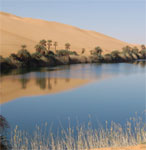
Evaporating the Water Mirage
Experts analyze global water supply, propose solutions for dealing with dwindling resources
- By Debbie Bolles
- Dec 01, 2007
The view of our planet from space
masks a perplexing irony. With water
covering 71 percent of the Earth’s surface,
we would expect plenty of this
life-sustaining resource to go around.
But the reality is that clean, usable
drinking water supplies grow scarcer
each year, impacted by climate
change, pollution, urban development,
agricultural production, and
population growth.
“Since 1947, consumptive water
use worldwide has grown more than
400 percent,” said Reagan Waskom,
director of Colorado State University’s
Water Resources Center. Waskom
spoke at a media conference on water
sponsored by the Property and Environmental
Research Center (PERC)
and the Sand County Foundation.
Waskom’s sobering data on global
water usage set the
stage for a discussion of
strategies to conserve
fresh water sources,
including how innovative
water market trading can
preserve flows and keep
waterways clean.
An overview of the
global water supply,
threats to world water
resources, solutions from entrepreneurs involved
in water market trading programs, and a status
report on current methods for providing safe
drinking water were shared with a select group
of journalists at the PERC conference. The
event was held Sept. 27-30, 2007, at Lone
Mountain Guest Ranch in Big Sky, Mont.
A water-short world
“Much of the world will face an acute shortage
of water in the next two decades,” predicted
Waskom. “Water use in 2000 was estimated
to be about 30 percent of the world’s total accessible
fresh water supply. That fraction may reach
70 percent by 2025.”
Waskom said an estimated 2.4 billion people
now live in water-stressed environments.
About one in six people worldwide do not have
easy access to clean, fresh water. Asia is home to
60 percent of the world’s population; that same
land mass provides only 30 percent of global
water supply.
Even in the United States, issues complicating
the ability to supply drinking water for the
future include an aging infrastructure and
extended dry periods. Conservation and reuse
must be part of the solution as communities
start to deal with water scarcity, Waskom said.
New threats to quality are becoming an
issue, even with current water supplies.
Gretchen Rupp, director of the Montana
Water Center, said algal blooms related to
excess nitrogen runoff from fertilizer increasingly
are becoming a problem in U.S. reservoirs,
while in other parts of the world seawater
intrusion into aquifers affects the quality of
water used for irrigation. Excess nutrients discharged
to water, in particular nitrogen, are
affecting aquatic life, leading to nearly 200 oxygen-
depleted water zones worldwide.
Another problem is the current inability of
wastewater treatment plants to remove pharmaceuticals
that enter waste streams and affect
aquatic life.
Climate change impact
Evidence continues to grow that global warming
will bring less rain and extended drought
to parts of the world in the future. Effects
already seen in the United States include a
snow pack level in California that is at its lowest
point ever and a projected 10 percent to 40
percent reduction in Colorado River runoff,
said Kathy Jacobs, executive director of the Arizona
Water Institute, a consortium of three
Arizona universities. Jacobs co-authored the
“U.S. National Assessment of the Impacts of
Climate Change,” a report produced for the
federal government by the National Assessment
Synthesis Team.
“There is literally no debate now that warming
is happening,” said Jacobs. “We’re seeing all
kinds of effects.”
With overallocation of water resources, what
would be considered a typical drought will have
larger repercussions, she added. Areas of the
Southwest in the United States already are feeling
some climate change effects, and water
providers across the country are enacting local
drought plans.
Among possible solutions for arid regions
facing a dwindling water supply are desalination,
reuse programs, weather modification technology,
expansion of surface water storage, and
integration of water delivery systems.
Water markets: one solution?
Several speakers promoted the use of trading
water rights to reallocate and ultimately conserve
water resources, a free-market position
advocated by PERC. Mainly used in the United
States as a tool to enhance stream flows and
protect fish or endangered species, experts agreed
this incentive-based market mechanism will gain
popularity as usable water becomes scarce.
Since 1998, nearly 6 million acre feet of water
has been restored to instream flows through lease
or purchase of water rights by federal, state, and
private entities. Most of this activity has been related
to protecting waterways for endangered species.
Similar activity is taking place regarding
anti-pollution efforts. The Sand County Foundation,
for example, is piloting a program that
offers financial aid to farmers along the Upper
Mississippi River to reduce nitrogen discharge
from their land.
This article originally appeared in the 12/01/2007 issue of Environmental Protection.
About the Author
Debbie Bolles is managing editor of Water & Wastewater News.